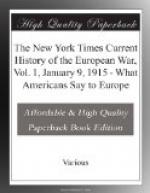Thirdly, this policy of absolute annihilation of Belgium, of its right to live its own life, its right even to preserve those monuments of its noble and beautiful history which had become treasured heirlooms of the whole world, has been carried out with a ruthless barbarity to the people, and especially the non-combatants, for which it is hard to find a parallel in the worst incidents of the Thirty Years’ War or of the devastation of the Palatinate. To bring the actual guilt home to those who actually did or ordered these deeds to be done in individual cases is one thing. The broad fact that these barbarous deeds were done stands manifest and insistent, and demands such instant action as can be taken by a great and responsible people.
And, lastly, there is the undisguised adoption of the policy of terrorizing non-combatants to submission by such acts as forcing women and children to walk before the advancing enemy, the wholesale burning of houses, shooting of hostages and other non-combatants, and the dropping of bombs from aeroplanes not on forts or troops, but on places where women and children can be killed or injured.
And all this tragic sweeping away of such good things as had been won with worldwide consent, at the instance of the Czar in initiating The Hague policy, has gone on, so far as it could go on, with equal horror, throughout Northern France. Rheims and Senlis have suffered the fate of Louvain and Termonde and Malines, and Paris has had her quota of women and children wantonly slain by bombs, exactly like Antwerp.
The Threat to England.
And America knows, as we here in England know, from the open menace of the German press, writing of England as the one supreme enemy, that it is the full intention of Germans, if they can, to carry through England, too, even more ruthlessly, the same policy.
We are fighting here, and are confident that we shall fight with success, not only to protect our English homes and to guard the historic buildings of this land but to make an end of this Prussian terrorism of the world; to secure no national aggrandizement, but to secure a permanent and solid peace, based on guaranteed liberties, and a rational settlement of the question of armaments.
These questions touch us all the more because many of us have been the most persistent friends of international peace and have specially labored to promote happy and friendly relations with the German people. The present writer, who was honored by election as President of this year’s National Peace Congress, has been associated with the work of men like Lord Brassey, Sir John Lubbock, (later Lord Avebury,) as a member of the Anglo-German Friendship League, and has repeatedly in Parliament argued against any hostile or provocative attitude toward Germany. This war is our answer and our reward!
America in the Settlement.
So far as can be judged from authoritative words of President Wilson and ex-President Roosevelt, America does and will claim a right to share in the final settlement of the terms of a permanent and stable peace.




